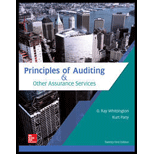
Principles Of Auditing & Other Assurance Services
21st Edition
ISBN: 9781259916984
Author: WHITTINGTON, Ray, Pany, Kurt
Publisher: Mcgraw-hill Education,
expand_more
expand_more
format_list_bulleted
Question
Chapter 9, Problem 37EOQ
To determine
Identify the appropriate answer related to effective discovery sampling.
Expert Solution & Answer
Want to see the full answer?
Check out a sample textbook solution
Students have asked these similar questions
I don't need ai answer general accounting question
Question
Could you help me solve this financial accounting question using appropriate calculation techniques?
Chapter 9 Solutions
Principles Of Auditing & Other Assurance Services
Ch. 9 - Prob. 1RQCh. 9 - Prob. 2RQCh. 9 - Prob. 3RQCh. 9 - Prob. 4RQCh. 9 - Prob. 5RQCh. 9 - Prob. 6RQCh. 9 - Prob. 7RQCh. 9 - Prob. 8RQCh. 9 - Prob. 9RQCh. 9 - Prob. 10RQ
Ch. 9 - Prob. 11RQCh. 9 - Prob. 12RQCh. 9 - What is a dual-purpose test?Ch. 9 - Prob. 14RQCh. 9 - Prob. 15RQCh. 9 - Prob. 16RQCh. 9 - What would be the difference between an attributes...Ch. 9 - Prob. 18RQCh. 9 - Prob. 19RQCh. 9 - Prob. 20RQCh. 9 - Prob. 21RQCh. 9 - Prob. 22RQCh. 9 - Prob. 23RQCh. 9 - Prob. 24RQCh. 9 - Prob. 25RQCh. 9 - Prob. 26RQCh. 9 - Prob. 27RQCh. 9 - Prob. 28RQCh. 9 - Prob. 29QRACh. 9 - Prob. 30QRACh. 9 - Prob. 31QRACh. 9 - Prob. 32QRACh. 9 - Prob. 33QRACh. 9 - Prob. 34QRACh. 9 - Prob. 35QRACh. 9 - Prob. 36QRACh. 9 - Prob. 37AOQCh. 9 - Prob. 37BOQCh. 9 - Prob. 37COQCh. 9 - Prob. 37DOQCh. 9 - Prob. 37EOQCh. 9 - Prob. 37FOQCh. 9 - Prob. 37GOQCh. 9 - Prob. 37HOQCh. 9 - Prob. 37IOQCh. 9 - Prob. 37JOQCh. 9 - Prob. 37KOQCh. 9 - Prob. 37LOQCh. 9 - Prob. 38OQCh. 9 - Prob. 39OQCh. 9 - For each term in the first column below, identify...Ch. 9 - Prob. 41OQCh. 9 - Smith, Inc. Rachel Robertson wishes to use...Ch. 9 - Prob. 43OQCh. 9 - Prob. 44PCh. 9 - Prob. 45PCh. 9 - Prob. 46PCh. 9 - Prob. 47PCh. 9 - In the audit of Potomac Mills, the auditors wish...Ch. 9 - Prob. 49PCh. 9 - Prob. 50PCh. 9 - Prob. 51PCh. 9 - Prob. 52ITC
Knowledge Booster
Similar questions
- Silva Manufacturing's output for the current period was assigned a $260,000 standard direct materials cost. The direct materials variances included a $4,500 favorable price variance and a $6,000 unfavorable quantity variance. What is the actual total direct materials cost for the current period?arrow_forwardIf image is blurr then please comment below i will write values. if you answer with incorrect values i will give unhelpful confirm.arrow_forwardVanderbilt Trading Co. is a retail merchandiser with the following information: . Yard Maintenance: $8,000 • • • • • Delivery Expense: $1,500 Freight-in: $400 Purchases: $60,000 Ending Inventory: $7,500 Beginning Inventory: $10,000 ⚫ Revenues: $90,000 • What is the Cost of Goods Sold (COGS) for Vanderbilt Trading Co.?arrow_forward
- I want to this question answer for General accounting question not need ai solutionarrow_forwardDBZ Company produces two products, Gamma and DBZ. Gamma is a high-volume item totaling 25,000 units annually. DBZ is a low-volume item totaling only 8,000 units per year. Gamma requires 1.5 hours of direct labor for completion, while each unit of DBZ requires 3 hours. Therefore, total annual direct labor hours are 55,500 (25,000 × 1.5 + 8,000 × 3). Expected annual manufacturing overhead costs are $720,000. DBZ uses a traditional costing system and assigns overhead based on direct labor hours. Each unit of DBZ would be assigned an overhead of:arrow_forwardCan someone please solve this?arrow_forward
arrow_back_ios
SEE MORE QUESTIONS
arrow_forward_ios
Recommended textbooks for you
 Auditing: A Risk Based-Approach (MindTap Course L...AccountingISBN:9781337619455Author:Karla M Johnstone, Audrey A. Gramling, Larry E. RittenbergPublisher:Cengage Learning
Auditing: A Risk Based-Approach (MindTap Course L...AccountingISBN:9781337619455Author:Karla M Johnstone, Audrey A. Gramling, Larry E. RittenbergPublisher:Cengage Learning Auditing: A Risk Based-Approach to Conducting a Q...AccountingISBN:9781305080577Author:Karla M Johnstone, Audrey A. Gramling, Larry E. RittenbergPublisher:South-Western College Pub
Auditing: A Risk Based-Approach to Conducting a Q...AccountingISBN:9781305080577Author:Karla M Johnstone, Audrey A. Gramling, Larry E. RittenbergPublisher:South-Western College Pub

Auditing: A Risk Based-Approach (MindTap Course L...
Accounting
ISBN:9781337619455
Author:Karla M Johnstone, Audrey A. Gramling, Larry E. Rittenberg
Publisher:Cengage Learning

Auditing: A Risk Based-Approach to Conducting a Q...
Accounting
ISBN:9781305080577
Author:Karla M Johnstone, Audrey A. Gramling, Larry E. Rittenberg
Publisher:South-Western College Pub